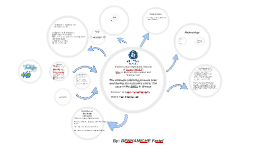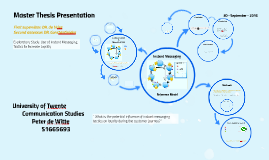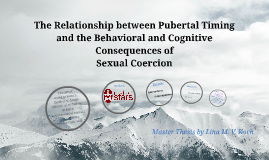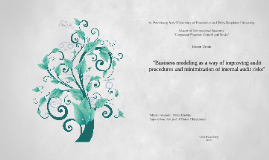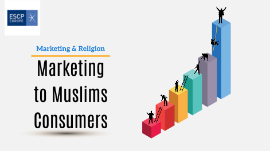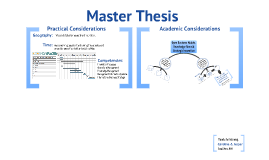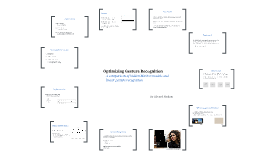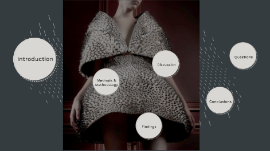Master thesis presentation
Transcript: “There is an annual meeting where we examine what has happened in the year that passed and we make the new plans for the year to come. But every month, we conduct follow up meetings to see if the targets we have set are being achieved and what modifications are needed. Sometimes there is no need to change anything, other times there is a need for small changes and some other times there is a need for a complete change our plans ...I tried to develop a formal planning system when I started the company by writing a manual on how things should be organized and what is the role of everyone in the company, but I soon realized that I spent time for no reason. It is very hard to keep up with a written strategic plan because you have to make modifications all the time so after a while I gave up on that. I believe that the strategic planning process in a SME cannot be of such sophisticated and formal nature” • What is the importance of the strategic planning process in addressing the crisis factors? • What is the content of the strategic planning process? • Is there any difference between the strategic planning process prior and during the economic crisis in Greece? • Were there any changes that occurred during the economic crisis? • What were the obstacles that SMEs faced during the economic crisis? main changes “The employees have a secondary and supportive role in the company and they are only following my orders concerning important decisions... they don’t have the knowledge or the experience to do some things that I need. So I am forced to be engaged with every problem or issue that comes up” limitation of the study obstacles The strategic planning process prior and during the economic crisis: The case of the SMEs in Greece Factor of decision making: Methodology Small and medium enterprises prior to economic crisis Battaglia, M. Frey, M. Public policies of promotion of CSR amongst SMEs and effects on competitiveness: the case of Tuscany region. Int. J. Business Governance and Ethics, Vol. 9, No. 1, 2014 Bourgeouis, L.J.III, Eisenhardt, K.M. (1988) strategic decision process in high velocity environments: four cases in the microcomputer industry. Management science Vol 34, No 7, pp 816 - 835. Giannacourou, M. Kantaraki, M. Christopoulou V. (2015) The Perception of Crisis by Greek SMEs and its impact on Managerial Practices. International conference on strategic innovative marketing, IC-SIM, Madrid, Spain, pp.546-551. GSEVEE, ESEF, KEEE, TFGR, SETE, (2014) The development of SMEs in Greece. Policy document, chapter2, 66p. Vargo, J, Seville, E. (2011) Crisis strategic planning for SMEs: Finding the silver lining. International journal of production research – creating Resilient SMEs special issue, Vol 49, Issue 18, pp5619-5635. Chapter 2: Example of company A Qualitative Chapter 3: Small and medium enterprises during to economic crisis What is the strategic planning process followed by the SMEs in Greece, prior and during the economic crisis? Sub questions company B Background to the research Significance of the study Aims, Research questions and objectives Aim of the study Delimitation of study Structure of study Quantitative focusing on the tourism sector: Travel agencies. Company A is not using any written plans for strategic purposes and the strategy formulation has a horizon of 3 to 6 months. The decision-making in the firm was heavily centered on the owner-manager. Issue of self-reported questionnaires Potential sampling bias presented in the sample profile The lack of industry standardization the lack of time in terms of companies' replies chapter1: introduction and literature review Mediterranean Agronomic Institute of Chania (MAICh) MSc in Business Economics and Management No written plans are produced but their long planning horizons are narrow and there is a detailed plan of strategic activities. The decision-making process is centralized, since the owner-manager is the one making the decisions, with minimum contribution and participation from other employees. Conclusion By: BENHAMICHE Feriel Research Question “I am responsible for taking the important decisions, because I am the one responsible and accountable for the firm ...I don’t have any trust issues but you must know that you will never find a businessman who will let others decide for them. I am the one who risk his future so I am the one who will decide what will happen” the use of interviews as a method of research interview guide target : 15 companies travel agencies 5 interviews done using the door to door in Chania. next target (Athens). the companies' name will not be revealed for confidentiality reasons. example: Company A, B, C... Introduction Strategies during the economic crisis: overview of SMEs’ strategies in Greece during the economic crisis Introduction Definition of SMEs: Defining the tourist sector SMEs (travel agencies) Importance of the SMEs Strategies before the economic crisis: overview of SMEs’ strategies in Greece prior the






